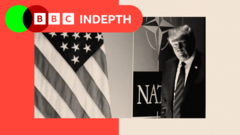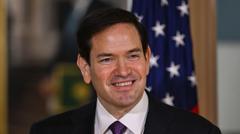The Strait, a critical shipping channel, transports 20% of the world’s oil, making any disruption a significant threat to global trade and economies, particularly in Asia.
**Strait of Hormuz Under Threat: Potential Global Economic Fallout of Iran's Moves**

**Strait of Hormuz Under Threat: Potential Global Economic Fallout of Iran's Moves**
Iran's possible closure of the Strait of Hormuz could ignite a global economic crisis by crippling oil supplies.
The ongoing feud between the United States and Iran has brought the Strait of Hormuz into the spotlight once again, heightening concerns about the potential for Iran to block this vital oil shipping corridor. Approximately 20% of the world’s oil and gas passes through the Strait, making it one of the most crucial maritime chokepoints globally. Such a blockade could lead to soaring oil prices and drastic impacts on global trade, affecting major economies like China, India, and Japan that rely heavily on energy imports.
The Strait of Hormuz connects the Persian Gulf to the Arabian Sea and is flanked by Iran to the north and Oman and the UAE to the south. At its narrowest point, the strait measures just 33 kilometers wide, allowing for the passage of some of the largest oil tankers. In recent months, nearly 20 million barrels of oil traversed this strait daily, translating to an energy trade worth around $600 billion per year.
Former MI6 chief, Sir Alex Younger, emphasizes the catastrophic repercussions of closing the strait, noting it would prompt significant disruptions to oil prices, while Bader Al-Saif, a political analyst, describes such an action as "uncharted territory" that would send shockwaves through global markets. The ramifications would also extend to Gulf nations like Saudi Arabia, which depend on this route for exporting millions of barrels daily, thereby impacting their economies substantially.
Iran's economic dependency on oil exports makes this situation particularly delicate. In recent years, the country has seen burgeoning oil revenues, peaking at $67 billion in 2025, despite international sanctions. Conversely, Asian markets are at risk, as countries such as India, South Korea, and Japan source a significant percentage of their crude oil and natural gas through the Strait. A blockage could cascade into increased costs for fuel and production, exacerbating inflationary pressures worldwide.
Experts outline that while Iran could attempt to close the Strait using naval forces or mines, the reality is that U.S. and allied leveraging military capabilities could quickly restore maritime traffic. Historical incidents, such as the "tanker war" during the Iran-Iraq conflict, have shown that the U.S. can respond effectively to secure oil shipping routes.
Despite Iran's rhetoric surrounding the closure of the Strait, historical patterns suggest that actual implementation could be unlikely. Officials from the U.S., including Secretary of State Marco Rubio, warn that such a move would equate to "economic suicide" for Iran, which would endanger its strategic relationship with allies like China. The economic ramifications of a blockade would likely lead China to exert pressure on Iran to avoid such actions.
As concerns about potential blockades rise, countries within the Gulf region are proactively developing alternative routes to mitigate this risk. Saudi Arabia has enhanced its East-West pipeline, and the UAE has established connections to offshore ports. These alternatives could absorb a portion of the oil currently shipped through the strait but would still leave a substantial amount of traffic reliant on the waterway.
The geopolitical landscape is, thus, heavily intertwined with the prospects of the Strait of Hormuz's operation, underscoring the importance of diplomatic efforts to ensure the stability of one of the world's key energy corridors.
The Strait of Hormuz connects the Persian Gulf to the Arabian Sea and is flanked by Iran to the north and Oman and the UAE to the south. At its narrowest point, the strait measures just 33 kilometers wide, allowing for the passage of some of the largest oil tankers. In recent months, nearly 20 million barrels of oil traversed this strait daily, translating to an energy trade worth around $600 billion per year.
Former MI6 chief, Sir Alex Younger, emphasizes the catastrophic repercussions of closing the strait, noting it would prompt significant disruptions to oil prices, while Bader Al-Saif, a political analyst, describes such an action as "uncharted territory" that would send shockwaves through global markets. The ramifications would also extend to Gulf nations like Saudi Arabia, which depend on this route for exporting millions of barrels daily, thereby impacting their economies substantially.
Iran's economic dependency on oil exports makes this situation particularly delicate. In recent years, the country has seen burgeoning oil revenues, peaking at $67 billion in 2025, despite international sanctions. Conversely, Asian markets are at risk, as countries such as India, South Korea, and Japan source a significant percentage of their crude oil and natural gas through the Strait. A blockage could cascade into increased costs for fuel and production, exacerbating inflationary pressures worldwide.
Experts outline that while Iran could attempt to close the Strait using naval forces or mines, the reality is that U.S. and allied leveraging military capabilities could quickly restore maritime traffic. Historical incidents, such as the "tanker war" during the Iran-Iraq conflict, have shown that the U.S. can respond effectively to secure oil shipping routes.
Despite Iran's rhetoric surrounding the closure of the Strait, historical patterns suggest that actual implementation could be unlikely. Officials from the U.S., including Secretary of State Marco Rubio, warn that such a move would equate to "economic suicide" for Iran, which would endanger its strategic relationship with allies like China. The economic ramifications of a blockade would likely lead China to exert pressure on Iran to avoid such actions.
As concerns about potential blockades rise, countries within the Gulf region are proactively developing alternative routes to mitigate this risk. Saudi Arabia has enhanced its East-West pipeline, and the UAE has established connections to offshore ports. These alternatives could absorb a portion of the oil currently shipped through the strait but would still leave a substantial amount of traffic reliant on the waterway.
The geopolitical landscape is, thus, heavily intertwined with the prospects of the Strait of Hormuz's operation, underscoring the importance of diplomatic efforts to ensure the stability of one of the world's key energy corridors.























